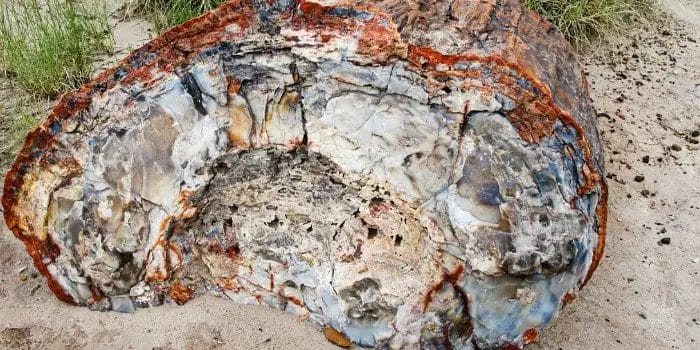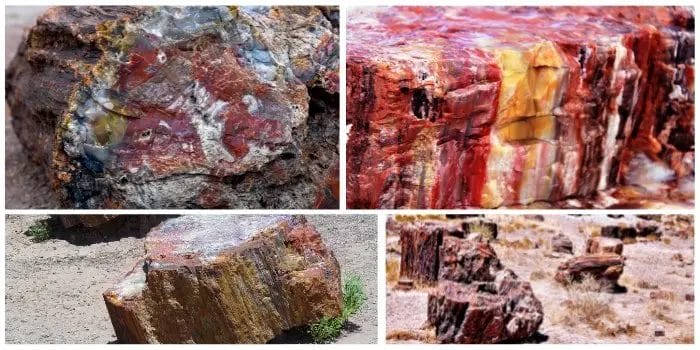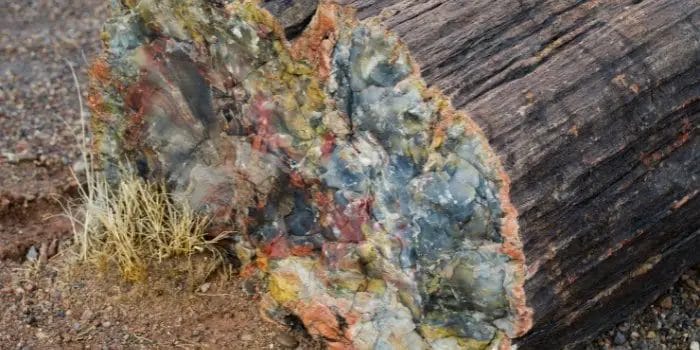Petrified wood is a fascinating natural phenomenon that occurs when wood is transformed into stone over time. This process, known as fossilization, results in beautiful and unique pieces of wood that have been hardened by minerals. One common misconception about petrified wood is that it is heavy due to its stone-like composition. However, the weight of petrified wood can vary depending on factors such as density and size. While some pieces can be relatively heavy, others may surprise you with their lighter weight. Let’s explore more about the weight of petrified wood and its characteristics.

Petrified Wood: How Heavy Can It Get? Unraveling the Weight Range of Petrified Wood
Petrified wood is a fascinating natural phenomenon that has captivated scientists and nature enthusiasts for centuries. The process by which organic wood transforms into solid rock is truly remarkable. But have you ever wondered just how heavy petrified wood can get?

When we think of wood, we typically associate it with something lightweight and easy to handle. However, petrified wood can be quite different. Due to the conversion of organic matter into minerals, petrified wood can become significantly heavier and denser than its original form.
The weight of petrified wood can vary greatly depending on a variety of factors, including the type of wood, the conditions under which it petrified, and the specific minerals that replaced the organic material. In general, petrified wood can range in weight from a few pounds to several tons.
The weight range of petrified wood is primarily influenced by the mineralization process. When a tree or piece of wood becomes buried under sediment or volcanic ash, it becomes isolated from oxygen and decomposes very slowly. Over time, mineral-rich groundwater seeps into the wood and begins to replace the organic material with minerals such as silica, quartz, and calcite.
As the mineralization process continues, the wood gradually transforms into solid rock while retaining the original structure and appearance. The minerals fill in the cavities and cells of the wood, effectively turning it into a fossil. This transformation from wood to stone results in a significant increase in weight and density.
The weight of petrified wood can also be influenced by the type of wood that underwent petrification. Some woods, such as oak and pine, have a higher density to begin with, which can result in heavier petrified wood specimens. On the other hand, softer woods like cedar may have lower density even after petrification.
Another factor that contributes to the weight range of petrified wood is the specific minerals that are present in the petrified specimen. Different minerals have different densities, and their presence in the petrified wood can impact its overall weight. For example, petrified wood with a high concentration of quartz may be heavier than specimens with a higher proportion of calcite.
In summary, petrified wood can vary greatly in weight, ranging from a few pounds to several tons. The weight is influenced by factors such as the type of wood, the conditions of petrification, and the specific minerals present in the specimen. This weight range highlights the transformative power of nature and the incredible process that turns organic matter into beautiful and enduring petrified wood.

The Significance of Weight in Petrified Wood: Implications for Collectors and Enthusiasts
Petrified wood, with its captivating beauty and intriguing history, has been a popular choice for collectors and enthusiasts alike. Its unique characteristics, such as vibrant colors and intricate patterns, make it a highly sought-after gemstone. While many factors contribute to the value and desirability of petrified wood, weight plays a significant role in determining its worth. In this section, we will explore the importance of weight in petrified wood and its implications for collectors and enthusiasts.
1. Weight as an Indicator of Quality
When it comes to petrified wood, weight is often seen as an indicator of quality. Heavier specimens tend to be denser and more solid, indicating a higher mineral content. This mineralization process is essential in the formation of petrified wood, as it replaces the organic material with minerals, resulting in the preservation of its structure.
Collectors and enthusiasts value heavier petrified wood pieces as they are considered to be more stable and durable. These specimens are less prone to breakage and damage, making them ideal for display and showcase. Additionally, the weight of the petrified wood also contributes to its aesthetic appeal, giving it a substantial feel and presence.
2. Weight as a Determinant of Rarity
The weight of petrified wood can also have implications for its rarity. Larger and heavier specimens are typically harder to find and extract, making them more uncommon and valuable. This rarity factor adds to the allure and exclusivity of the petrified wood piece, increasing its desirability among collectors.
Furthermore, the weight of petrified wood can also provide insights into its origin and geological history. Different regions and environments produce distinct types of petrified wood, each with its own unique characteristics. The weight of the specimen can help identify its geological source and provide valuable information for collectors and enthusiasts interested in the origin and authenticity of the piece.
3. Weight in Relation to Size and Shape
While weight is an important factor on its own, it is often considered in conjunction with the size and shape of the petrified wood. Collectors and enthusiasts look for a harmonious balance between these three elements when evaluating a piece.
For example, a large and heavy petrified wood log with an irregular shape may not be as desirable as a smaller and well-proportioned piece with a similar weight. The aesthetics and visual appeal of the specimen also come into play when determining its value.
4. Weight and Pricing
Due to its significance in determining quality, rarity, and desirability, weight plays a crucial role in pricing petrified wood specimens. Heavier and rarer pieces generally command higher market prices, reflecting their uniqueness and value.
Collectors and enthusiasts should be aware of the weight-to-price ratio when considering the purchase of petrified wood. It is essential to evaluate the overall quality and characteristics of the specimen, including its weight, to ensure a fair and reasonable price.
Summary
In summary, weight holds great significance in the world of petrified wood. It serves as an indicator of quality, rarity, and durability. The weight of a petrified wood specimen contributes to its aesthetic appeal, while also providing valuable information about its origin and geological history. When evaluating and pricing petrified wood, collectors and enthusiasts consider the weight in relation to size, shape, and overall quality. By understanding the implications of weight in petrified wood, collectors can make informed decisions and build impressive collections.

Demystifying the Weight of Petrified Wood: Factors Influencing its Heaviness
Petrified wood is a fascinating natural phenomenon that occurs when organic wood material is replaced with minerals over time. One common question that often arises is: why is petrified wood so heavy? In this section, we will explore the various factors that contribute to the weight of petrified wood and shed light on this intriguing aspect.
1. Mineralization Process
Petrified wood undergoes a process called mineralization, where the original organic material is gradually replaced by minerals such as silica, quartz, and calcite. This process occurs over thousands of years in specific geological conditions. The type and amount of minerals that replace the wood fibers can significantly impact the weight of the resulting petrified wood.
When minerals fill the voids left by the decaying wood fibers, they add mass to the overall structure. Different minerals have varying densities, which can affect the final weight of petrified wood. For example, petrified wood rich in silica will generally be heavier than those with less silica content.
2. Porosity and Density
The porosity and density of petrified wood also contribute to its weight. Porosity refers to the amount of empty space or pores within the material. Higher porosity means more empty spaces, which can make the wood lighter. On the other hand, lower porosity indicates a denser structure, resulting in a heavier weight.
The density of petrified wood is influenced by various factors, including the type of trees that were fossilized, the geological environment, and the duration of the mineralization process. Denser wood varieties, such as hardwoods, tend to produce heavier petrified wood compared to softer wood types.
3. Size and Shape
The size and shape of petrified wood specimens also play a role in determining their weight. Larger pieces of petrified wood naturally weigh more due to their increased volume. Similarly, irregularly shaped specimens with intricate patterns and details may contain more mineralized material, contributing to their overall weight.
Moreover, the presence of growth rings in petrified wood can affect its weight. The growth rings are formed by the annual growth cycles of the tree and can provide valuable insights into the age of the specimen. As a general rule, petrified wood with more growth rings will typically be heavier as it represents a longer period of mineralization.
4. Water Content
The water content within petrified wood can also influence its weight. When wood is initially fossilized, it may retain some of its original water content. As the mineralization process occurs, the water is gradually replaced by minerals. However, if the petrified wood is still relatively new or has not undergone extensive mineralization, it may retain more water, thereby increasing its weight.
Summary
In summary, the weight of petrified wood is influenced by several key factors, including the mineralization process, porosity and density, size and shape, and water content. The type and amount of minerals, as well as the density of the wood, play a significant role in determining the overall weight. Additionally, larger specimens and those with intricate patterns may be heavier, while the water content can also impact the weight of freshly petrified wood. Understanding these factors can help demystify why petrified wood is so heavy and provide valuable insights into this remarkable natural phenomenon.
Petrified Wood: Weight Considerations for Display, Transportation, and Handling
Petrified wood is a fascinating geological wonder that has captivated the attention of collectors, enthusiasts, and nature lovers alike. Its unique beauty and rich history make it a prized possession for many. However, when it comes to displaying, transporting, and handling petrified wood, weight considerations play a crucial role.
1. Understanding the Weight of Petrified Wood
Petrified wood is essentially fossilized wood that has undergone a process of mineral replacement. As a result, it becomes heavier than its original form. The weight of petrified wood can vary significantly depending on its size, density, and composition. Larger pieces of petrified wood can weigh several hundred pounds, while smaller specimens may weigh just a few pounds.
2. Displaying Petrified Wood
When it comes to displaying petrified wood, it is essential to consider the weight of the piece and the structural integrity of the display area. Here are a few key points to keep in mind:
- Support: Petrified wood can be quite heavy, so it is crucial to provide adequate support to prevent any damage or accidents. Display stands, pedestals, or wall-mounted brackets made of sturdy materials like metal or wood can help distribute the weight evenly.
- Size: The size of the petrified wood piece should also be taken into account. Larger pieces may require custom-built display units or specialized support systems.
- Accessibility: Consider the ease of access when choosing a display location. Petrified wood can be challenging to move due to its weight, so it is advisable to choose a display area where it can remain undisturbed.
3. Transportation and Handling
Transporting and handling petrified wood requires careful planning and consideration due to its weight. Here are some tips to ensure safe transportation and handling:
- Equipment: Use appropriate equipment such as dollies, carts, or lifting straps to move heavy petrified wood. These tools can help distribute the weight and minimize the risk of injuries.
- Protective Measures: To prevent damage during transportation, wrap the petrified wood in padding or bubble wrap. This will cushion the piece and provide a protective layer against any potential impact.
- Secure Packaging: When shipping petrified wood, ensure it is well-packaged in a sturdy box or crate to prevent any movement or breakage. Fill any empty spaces with packing material to minimize shifting.
4. Seeking Professional Assistance
If you are dealing with large or exceptionally heavy pieces of petrified wood, it is advisable to seek professional assistance. Experienced movers or specialized petrified wood handling services can provide the expertise and equipment required to ensure safe transportation and handling.
5. Conclusion
When it comes to displaying, transporting, and handling petrified wood, weight considerations are paramount. Understanding the weight of the piece, providing proper support for display, and taking necessary precautions during transportation and handling are crucial to preserving the beauty and integrity of this unique geological treasure.
FAQs
Is petrified wood heavy?
Yes, petrified wood is typically heavy. The process of fossilization replaces the organic materials in wood with minerals over time, resulting in a hard and dense material. The weight of petrified wood can vary depending on its size and the minerals present, but it generally weighs more than regular wood.
Conclusion:
In summary, petrified wood is not just visually stunning, it also carries a considerable weight due to its mineral replacement process. The transformation of organic material to stone creates a dense and heavy substance. Its weight can vary depending on the type of wood and the degree of mineralization. However, it is important to note that while petrified wood is generally heavy, it is still lighter than most natural stones. Its unique combination of weight and beauty makes it a popular choice for home decor, jewelry, and even outdoor landscaping.
So, whether you’re fascinated by its weight or are simply looking for a captivating piece of history, petrified wood is a remarkable natural wonder that continues to captivate and amaze.